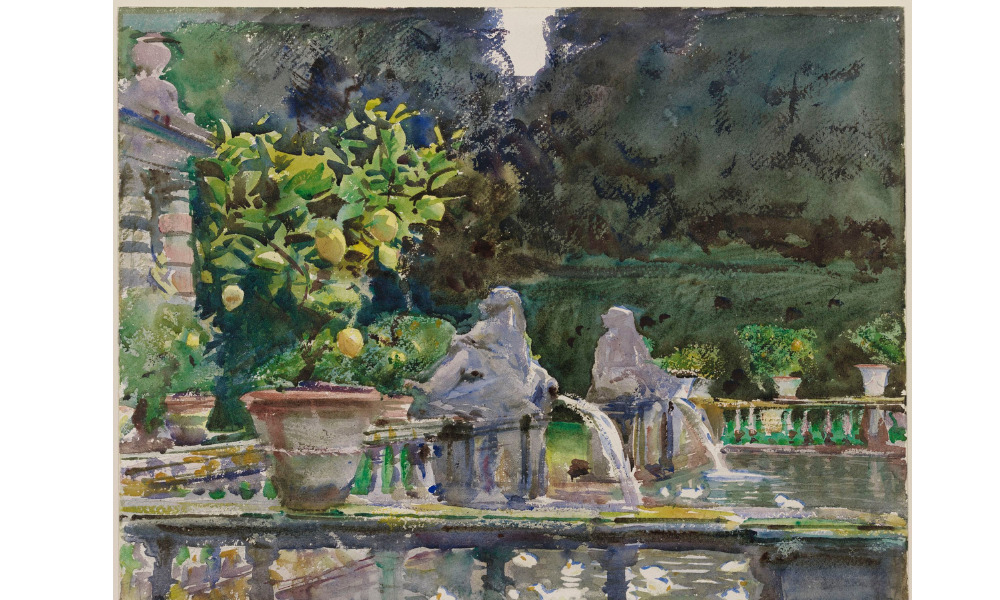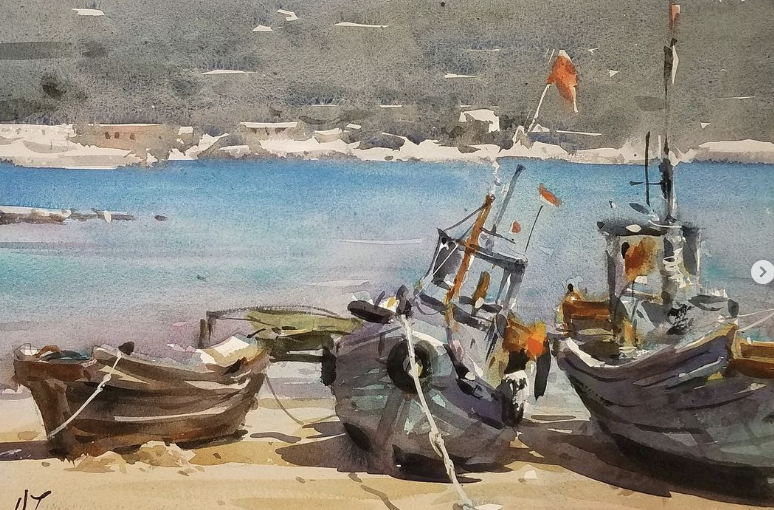Opaque Paint and Watercolor
featuring Andy Evansen
Using an opaque medium with watercolor is always a hot topic and some people think it is not true watercolor. seasoned watercolor artist Andy Evansen disagrees. John Singer Sargent’s watercolors are considered the best, and rightly so. His masterpieces are full of opaque paint. Many other watercolor artists from the past used it, too. Andy is not sure where the bad notion of opaque paint came from. Transparent watercolor is a different animal and when you are not able to rely on gouache, there is a different approach and it has to be more pre-meditated.
John Singer Sargent, Villa di Marlia, Lucca: A Fountain, 1910, translucent watercolor and touches of opaque watercolor and wax resist with graphite underdrawing
Andy does not use a ton of gouache but one of his favorite colors is made by Holbein Artists Material and it is lavender with some white in it. It is kind of an opaque watercolor. He likes to use it in his sky mixtures as it tends to take the edge off the strong cobalt blue. There are also colors in watercolor that are literally almost impossible to mix without getting some white in there. Andy also was talking about the colors in the desert, dust and neutral, and how a lot of times you have to add a little bit of gouache to some of those mixtures to dull them down and get the color you want. For some of the smaller things like the railings on a boat or rigging lines, you can scrape them out or use a small amount of gouache.
Side note: There is no way Sargent’s watercolors would have been THAT energetic if he was worrying about every little small shape. His paintings are so fresh and energetic because he wasn’t worried about that stuff and knew he could always go back in and add or fix. And sometimes, those little things that you may see as an issue turn out to be a huge addition to the looseness and flow of the painting.
When you are first learning, watercolor can be so nerve-wracking. Andy always reminds his students to worry about the big problems first and the little problems will take care of themselves. You can always come back in and fix those smaller areas with gouache. It does not matter what medium it is, the human mind tries fill it all out at first. People don’t start out as “loose” painters because you are first learning the mechanics of the medium. There are so many things to understand and get used to, especially with watercolor. It is a tricky medium to get used to the paint, consistency, and how wet your paper is. Worrying about little things like small white shapes is one of the problems Andy assumes artists have the freedom to not concern themselves with. He tries to make sure his students are creating good negative shapes and the large part of the painting process. Andy would rather see a loose painting that might have small issues where they are not going in and worrying about the small stuff.
Watercolor by Andy Evansen
When using gouache, Andy uses the same brushes as he does with his watercolors. But, he tends to use the smaller synthetic brush for gouache since it is usually saved for those smaller details. Gouache rinses right out. In general, you don’t want to leave the paint on your brush with watercolor, because it will dry. You will have to pay attention to your water so it isn’t getting gouache in it. Also, if you’re palette is white, be sure your gouache isn’t near your other colors as it could accidentally be mixed in.
One tip from Andy is If you need a pale blue highlight, just mix the gouache with cerulean blue watercolor paint. It does not have to be an all-white highlight. Andy gets his brush a little wet and sticks it straight into the tube of gouache so it dries a little more transparent and isn’t so strong of a highlight. Andy even sees oil painters using gouache occasionally. It’s an in-between medium that allows you to have a little bit more control while still getting that loose watercolor feel.
Andy Evansen is sought out for his intelligence in capturing the beauty of watercolor, and his inspirational teaching style. If you are interested in joining Andy, learn more below:


